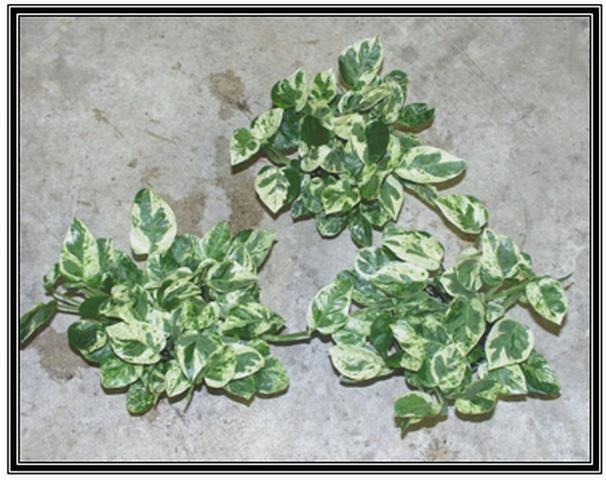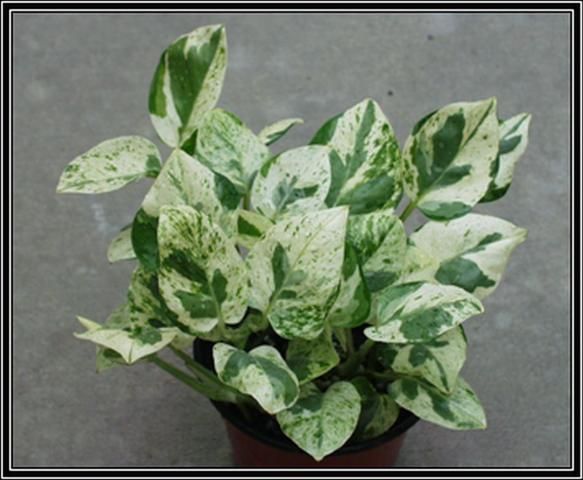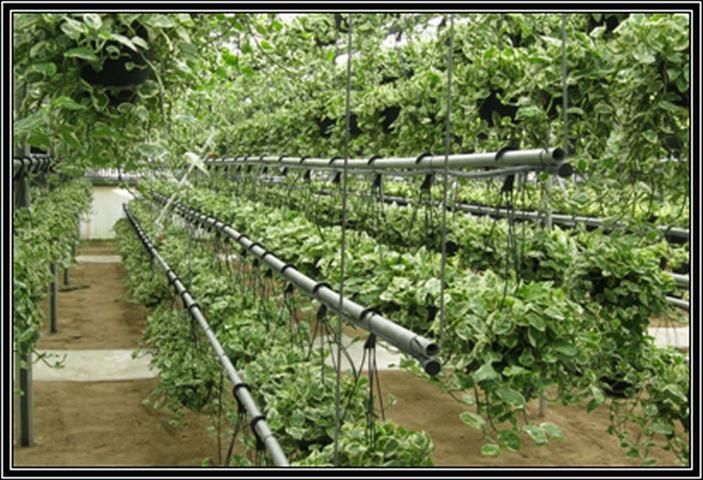Origin
Pothos (Epipremnum aureum) is enjoyed as an indoor houseplant for many purposes, including hanging baskets, small desk plants, totems, and dish gardens. In frost-free zones, it may also be used outdoors as a groundcover.
Four cultivars of pothos are common in the market. 'Golden' pothos has green leaves with bright yellow variegation. 'Marble Queen' pothos has green leaves with white variegation. 'Jade' pothos has uniform dark green leaves without variegation. 'Neon' pothos has bright chartreuse green-colored leaves with no variegation.
Pothos plants are tree-climbing vines native to the Solomon Islands, but they seldom flower even within their native habit. They do not flower under greenhouse conditions or in interior environments. As a result, no hybridized pothos cultivars are known to exist. Because of the barriers to hybridization, a program was initiated at the UF/IFAS Mid-Florida Research and Education Center (MREC) in Apopka, Florida, to induce mutations in order to develop new pothos varieties. Plants from all four available cultivars were treated. Pothos 'Pearls and Jade'® (Figure 1) is a mutation selection from a group of 'Marble Queen' plants.

Description
Pothos 'Pearls and Jade'® is a small plant. Mature leaves from 'Pearls and Jade'® reach an average of 7–8 cm (2.5–3.0 in.) long and 4–5 cm (1.5–2.0 in.) wide compared to 12 cm by 8 cm (4.5–3.0 in.) leaves on the parent plant 'Marble Queen'. 'Pearls and Jade'® leaves display white, gray, and green coloration in irregular patches, blotches, and streaks. These colored areas vary in size from a dot of less than 1 mm to large blotches covering over half the leaf surface. Each leaf varies slightly, which is typical for most variegation patterns in this genus, but the overall phenotypic effect is a pleasing uniform variegated appearance. The variegation is visible on both the top and bottom of the leaves (Figure 2).

The tops of the vines, where exposed to higher light levels, display a faint, striped effect due to narrow, alternating gray-green bands. The undersides of the vines have a similar pattern but with stripes of yellow green. Petiole colors follow the same pattern as the vines. Petioles tend to be approximately the same lengths as the attached leaf blade and range from 3 to 8 cm. Along the vines, space between the leaves varies from 2 to 7 cm depending on light levels, with lower light resulting in longer distances.
Performance
Using pothos 'Pearls and Jade'® stock plants that had been maintained in a shaded greenhouse at UF/IFAS MREC Apopka, 10 tip cuttings 2–3 cm in length and displaying 1–2 expanded leaves were harvested and placed 10 per pot in both 4 in. (0.6 L) and 6 in. (1.25 L) diameter pots containing Fafard #2 Mix (Conrad Fafard, Inc, Agawam, MA; 55% Canadian peat: 25% perlite: 20% vermiculite) in December 2007. The cuttings were rooted in a propagation chamber to maintain high humidity in a shaded greenhouse (maximum irradiance of 125 µmol.m-2.s-1) within a temperature range of 15°C–34°C (59°F–93°F) and under natural photoperiod. The cuttings were rooted and removed from the propagation chamber in January 2008. One week later, plants were fertilized with Nutricote® (18:6:9 ratio of N P205, K20; 140-day formulation; Chisso-Asahi Fertilizer Co., LTD, Tokyo, Japan). Plants in 4 in. (0.6 L) pots received 1.5, 2.5, or 3.5 g of fertilizer (1 tsp. = approximately 5.5 g) per pot. There were 10 replications per treatment. The 6 in. (1.6 L volume) diameter pots were treated with 3.5, 5.0, or 7.5 grams of fertilizer per pot with 8 replications per treatment. All pots were set on raised benches in a completely randomized experimental design and hand watered as needed.
Data recorded after 12 weeks of growth included canopy height and width, length of the longest vine (including the number of expanded leaves, the number of nodes, and the length and width of the largest leaf on the vine), and a visual quality rating, where 1 = dead, 2 = fair, 3 = acceptable (saleable), 4 = good, and 5 = excellent. Data were analyzed using ANOVA procedures of SAS (SAS Institute Inc., Cary, NC 27513).
Pothos 'Pearls and Jade'® performed well at all fertilizer levels, showing no significant differences in any parameters measured (Table 1). Overall plant quality averaged between good and excellent. All plants were above saleable quality. After final growth data were collected, all plants were moved into an interior growth room for 3 months with a light level of 25 µmol.m-2.s-1 (i.e., 100 foot-candles) for 12 hours daily at a constant 24°C to test for ability to tolerate the low light levels of interiorscape environments. After 3 months, all plants had performed well with no loss of foliar coloration and overall visual plant quality ratings of good to excellent.
Availability
Pothos 'Pearls and Jade'® is protected by US Plant Patent 21,217. Trademark and Plant Patent Rights issued through the United States Patent and Trademark Office are assigned to the University of Florida Board of Trustees. Stock plants have been released to licensed Florida growers for propagation and distribution (Figure 3). Inquiries regarding licensing may be sent to Florida Foundation Seed Producers, Inc., P.O. Box 110200, Gainesville, FL 32611. Plants for research purposes may be obtained directly from the author.

Additional Information
Henny, R. J., D. J. Norman, and J. Chen. 2004. "Progress in Ornamental Aroid Breeding." Annals of the Missouri Botanical Garden 91:465–473.
McConnell, D. B., J. Chen, R. J. Henny, and K. C. Everitt. 2003. Cultural Guidelines for Commercial Production of Interiorscape Epipremnum. ENH894. Gainesville: University of Florida Institute of Food and Agricultural Sciences. https://edis.ifas.ufl.edu/ep151.